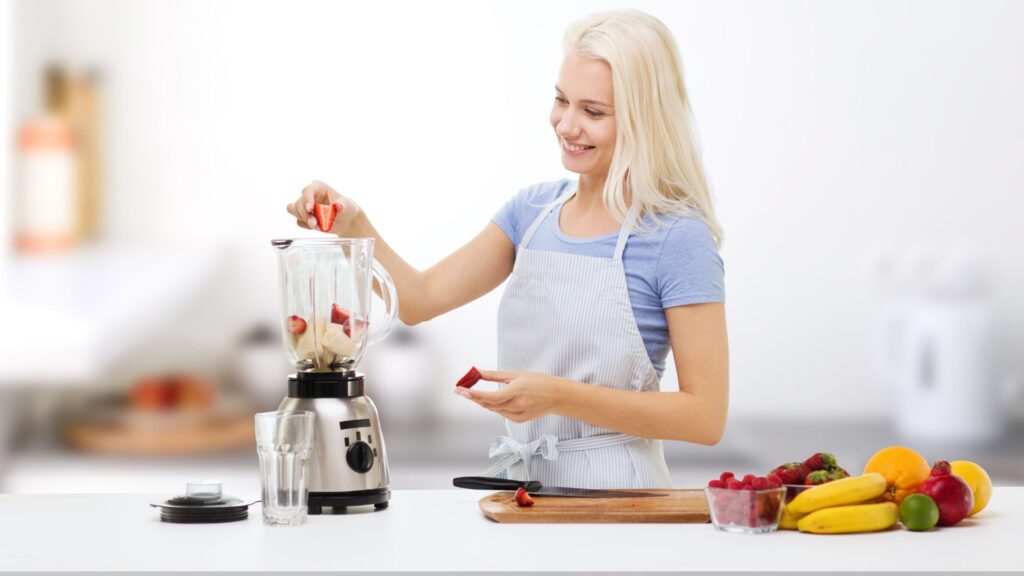Blenders have become a staple appliance in modern kitchens, whipping up everything from smoothies and cocktails to dips and desserts. But navigating the world of blender recipes can be daunting, especially if you’re new to this kitchen powerhouse.
Fear not, blender enthusiasts! This guide delves into the secrets of deciphering recipes and mastering the art of blending.

Understanding Ingredients:
- Fruits and Vegetables: These are the superstars of most blender recipes, providing vitamins, minerals, and fiber. Choose fresh, ripe produce for the best flavor and texture. Frozen fruits and vegetables are excellent alternatives when fresh options are unavailable.
- Liquids: Liquids, such as water, milk, juice, or yogurt, help achieve the desired consistency. Experiment with different liquids to discover new flavor profiles and dietary preferences.
- Protein Powders: For a protein boost, add protein powders like whey, soy, or pea protein. Choose powders that complement your dietary needs and taste preferences.
- Fats and Oils: Healthy fats like avocado, nut butter, or coconut oil add richness and creaminess to your blends. Use them sparingly for a balanced nutritional profile.
- Spices and Flavorings: Spices like cinnamon, ginger, and nutmeg, and flavorings like vanilla extract or almond extract, unleash a world of flavor possibilities. Don’t be afraid to experiment and find your favorite combinations.
Mastering the Techniques:
- Pulse blending: This involves short bursts of blending, allowing for better control over the texture and preventing over-blending. Pulse blending is ideal for chunky sauces, dips, and salsas.
- High-speed blending: Blending at high speed for longer intervals creates smooth, creamy textures, perfect for smoothies, soups, and nut butter. Be mindful of the ingredients and avoid over-blending, which can lead to a bitter taste.
- Layering ingredients: This technique helps achieve a consistent blend by layering ingredients from liquids to solids. It prevents larger pieces from getting stuck at the bottom and ensures even blending.
- Using the tamper: For thicker blends, use the tamper to push down the ingredients towards the blades, ensuring everything gets incorporated smoothly.
Beyond the Basics:
- Ingredient Substitutions: Don’t be afraid to experiment with different ingredients based on your preferences or dietary restrictions. Research suitable substitutes for fruits, vegetables, liquids, and spices.
- Adding Texture: Craving a bit of crunch? Add nuts, seeds, or granola to your blends for a delightful textural contrast.
- Freezing for Later: Many blended concoctions freeze well, making them ideal for meal prep or quick snacks. Portion your blends in freezer-safe containers and enjoy them on the go.
Additional Resources:
- Online blender recipe communities
- Blender cookbooks
- YouTube tutorials
Embrace the world of blending and create culinary masterpieces in your own kitchen!

Conquering Common Blender Challenges:
Even the most seasoned blender users encounter challenges sometimes. Here are solutions to common problems:
- Unevenly blended texture: This can occur due to under-blending, improper layering, or insufficient liquid. Pulse blend for longer intervals, ensure liquids are added first, and adjust the quantity if needed.
- Frozen ingredients not blending: Frozen fruits and vegetables can be tough on your blender. Add a splash of warmer liquid, start with a lower speed, and gradually increase as the ingredients begin to break down.
- Leaking blender: This can happen if the lid is not properly secured or the gasket is worn. Ensure the lid is on tight and replace the gasket if necessary.
- Burning smell: This usually indicates the motor is overheating. Stop blending immediately, allow the motor to cool, and reduce blending time or use a lower speed.
Unlocking the Power of Your Blender:
Blenders go beyond simple smoothies and dips. Here are some exciting ways to utilize this versatile appliance:
- Grind spices: Blend whole spices like peppercorns, cumin seeds, or coriander seeds to release their full flavor and aroma.
- Make nut butter: Grind nuts in your blender to create fresh, homemade nut butter. Start with a small amount and gradually increase the blending time until you reach the desired consistency.
- Whip up nut milk: Blend soaked nuts with water and strain for a healthy and delicious alternative to dairy milk.
- Prepare baby food: Steam or cook vegetables and fruits and blend them to a smooth consistency for your little one.
- Create homemade sauces and dressings: Blending fresh herbs, spices, and other ingredients allows for flavorful and customizable sauces and dressings.
- Mix and stir batters: Use your blender to mix ingredients for pancakes, waffles, or muffins, saving time and effort.
Blender Safety Tips:
- Always use the blender with the lid securely fastened.
- Don’t overload the blender. This can lead to overheating and damage the motor.
- Use the tamper only when necessary and with caution.
- Avoid blending hot liquids, as they can create pressure and cause the lid to pop off.
- Unplug the blender before cleaning.
- Clean the blender immediately after use to prevent the build-up of food particles and bacteria.
By following these guidelines and unleashing your creativity, your blender can become your go-to kitchen companion, aiding in creating healthy, delicious, and convenient meals and snacks.
So, explore the endless possibilities, experiment with flavors and techniques, and enjoy the journey of blending your way to culinary bliss!
Frequently Asked Questions
Q: What are some essential ingredients for blender recipes?
A: Fruits and vegetables are the foundation, providing vitamins, minerals, and fiber. Choose fresh, ripe produce for optimal flavor and texture. Frozen options are excellent substitutes when fresh isn’t available. Liquids like water, milk, or juice achieve desired consistency. Protein powders, healthy fats like avocado, and spices like cinnamon add further dimension and customization.
Q: What are the basic blending techniques?
A: Pulse blending involves short bursts for chunky dips and salsas. High-speed blending creates smooth smoothies and soups. Layering ingredients ensures even blending, and using the tamper helps incorporate thicker ingredients.
Q: How do I substitute ingredients in blender recipes?
A: Research suitable substitutes for fruits, vegetables, liquids, and spices based on your preferences or dietary restrictions. Online communities and cookbooks offer guidance.
Q: How can I add texture to my blends?
A: Nuts, seeds, and granola are excellent choices for a delightful crunch. Experiment with various combinations to discover your favorites.
Q: Can I freeze my blended concoctions?
A: Absolutely! Many blends freeze well for convenient meal prep or quick snacks. Portion them in freezer-safe containers and enjoy them later.
Q: What are some common blender challenges and solutions?
A: Uneven texture can result from under-blending, improper layering, or insufficient liquid. Pulse blend longer, ensure proper layering, and adjust liquid quantity as needed.
Frozen ingredients require a splash of warmer liquid and slower initial blending speed. Leaking may indicate an improperly secured lid or worn gasket. Tighten the lid or replace the gasket. Burning smells signify motor overheating.
Stop blending immediately, allow the motor to cool, and reduce blending time or use a lower speed.
Q: How can I use my blender beyond smoothies and dips?
A: Grind spices, make nut butter, prepare baby food, whip up nut milk, create sauces and dressings, and mix batters for pancakes, waffles, or muffins. The possibilities are endless!
Q: What are some safety tips for using a blender?
A: Always use the blender with the lid securely fastened, avoid overloading it, use the tamper with caution, and never blend hot liquids. Unplug the blender before cleaning and clean it immediately after use to prevent bacteria build-up.
Q: Where can I find more blender recipes and resources?
A: Explore online communities, blender cookbooks, and YouTube tutorials. Experiment with different ingredients and techniques to discover your blending passion!


1 thought on “Decoding Blender Recipes: A Comprehensive Guide to Understanding Ingredients and Techniques”
Comments are closed.